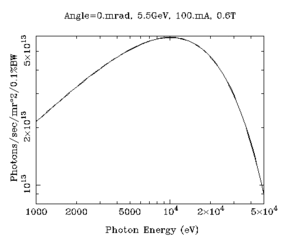Difference between revisions of "Basic formalism for X-ray monochromator resolution"
From GlueXWiki
| Line 1: | Line 1: | ||
The X-ray beam from a synchroton light source like CHESS originates in a small spot of rms typical dimensions of 1-2 mm. | The X-ray beam from a synchroton light source like CHESS originates in a small spot of rms typical dimensions of 1-2 mm. | ||
| − | The divergence of the beam is of order m/E which is 100 μr for CHESS running at 5.5 GeV. The energy spectrum depends on the beam line. | + | The divergence of the beam is of order m/E which is 100 μr for CHESS running at 5.5 GeV. The energy spectrum depends on the beam line. |
| + | [[Image:bendspec.gif|thumb|Source X-ray intensity spectrum for C1 beam line]] | ||
| + | C1 is a bend-magnet end station, so the spectrum is smooth from a few keV up to a broad maximum around 10 keV, above which it gradually drops off. There is very little intensity left above 50 keV. The spectrum at the left was generated using an online | ||
| + | [http://www-cxro.lbl.gov/optical_constants/bend2.html SR spectrum generator] on the Lawrence Berkeley web site. | ||
Revision as of 09:45, 10 March 2007
The X-ray beam from a synchroton light source like CHESS originates in a small spot of rms typical dimensions of 1-2 mm. The divergence of the beam is of order m/E which is 100 μr for CHESS running at 5.5 GeV. The energy spectrum depends on the beam line.
C1 is a bend-magnet end station, so the spectrum is smooth from a few keV up to a broad maximum around 10 keV, above which it gradually drops off. There is very little intensity left above 50 keV. The spectrum at the left was generated using an online SR spectrum generator on the Lawrence Berkeley web site.
